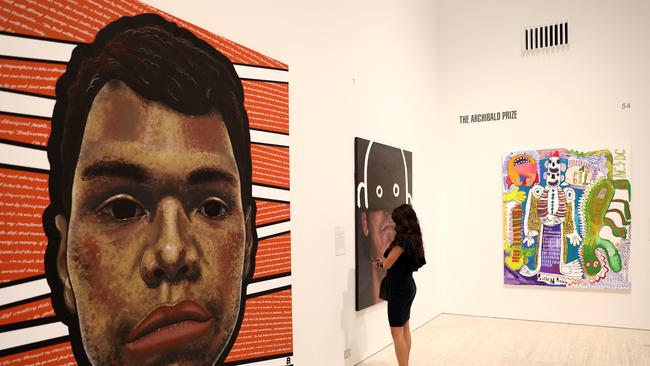Archibald Prize 2020: Vincent Namatjira wins for portrait with Adam Goodes
Vincent Namatjira became the first Indigenous person to win the $100,000 Archibald Prize for portraiture at the Art Gallery of NSW on Friday, with an emotional self-portrait with AFL legends Adam Goodes and Michael Long.
Arts
Don't miss out on the headlines from Arts. Followed categories will be added to My News.
Vincent Namatjira became the first Indigenous person to win the $100,000 Archibald Prize for portraiture at the Art Gallery of NSW on Friday, with an emotional self-portrait with AFL legends Adam Goodes and Michael Long.
Namatjira is the great grandson of the legendary Albert Namatjira, a desert artist who won international acclaim and was the subject of Sir William Dargie’s winning Archibald painting in 1956.
“It’s only taken 99 years,” Vincent Namatjira said with a laugh, referring to the fact the Archibald Prize turns 100 years old in 2021.

Namatjira was live streamed into the socially-distanced AGNSW just after noon on Friday from the community of Indulkana in the APY Lands in the north west of South Australia.
“I’m so proud to be the winner of the Archibald Prize, and to be the first Aboriginal artist to win is really special,” Namtjira said.
“I feel like this is a very important moment in Australian art. It’s an honour to be the first, but I also want to acknowledge all of the Indigenous finalists and Indigenous sitters for the Archibald this year and in past years.”
Namatjira’s painting, titled Stand strong for who you are, depicts AFL champion Adam Goodes, who has waged a public struggle against racism. Goodes appears in the painting three times. It also shows Michael Long, another famous AFL player who has spoken out against racism. And it shows Namatjira himself, holding the Indigenous flag.

Namatjira said his “guts were churning” when he saw the Goodes’ documentary The Final Quarter about Adam’s final season of AFL.
“I relived Adam’s experiences of relentless racism on and off the field. Memories of my own experiences were stirred up and I wanted to reach out and reconnect with Adam,” Namatjira said.
“We share some similar stories and experiences – of disconnection from culture, language and Country, and the constant pressures of being an Aboriginal man in this country.
“We’ve also both got young daughters and don’t want them to have to go through those same experiences.”
Artist and AGNSW trustee Ben Quilty – who was a judge of the Archibald – was in tears after the announcement, because of his deep involvement with the artistic communities of the APY Lands where he believes Australia’s greatest art is being made today.

“Vincent’s a friend and it just feels like the right thing. It’s a big moment for my friend and I think of his great grandfather and the hardship that he faced and his people faced and that Vincent faced. I just know there’ll be a party happening in Indulkana today.”
Curator Anne Ryan said Namatjira’s portrait told a powerful and ongoing story.
“We’ve got Adam Goodes wearing his jersey and pointing to his skin, referring to another AFL player Nicky Winmar who 20 years before had made the same gesture saying the same thing,” Ryan said.

“Next to Goodes is another AFL player Michael Long who walked to Canberra to speak to the government. We can see the red feet on the ground that refer to that long walk.”
Tony Albert, artist and trustee who also was on the judging panel for the Archibald, said it was a “significant moment”.
He said Sir William Dargie’s win with Albert Namatjira had “really shone a light on Aboriginal people, but it continued the perception that Aboriginal people needed to be seen and not heard”.

“The difference (this year) is Vincent is the artist. It was his painting. So we’re making history, it’s changing the vernacular. It’s the Aboriginal person in the position of power.”
Namatjira was highly commended in the Archibald in 2018 for his painting, Studio self-portrait, which is now in the AGNSW collection.
The judges on Friday also announced that Adelaide artist Tsering Hannaford was highly commended for her painting, Self-portrait after Allegory of Painting.

Other prizes also announced at the AGNSW on Friday were the Wynne Prize for landscape or figure sculpture. It was won by Hubert Pareroultja, a Western Aranda man from the Northern Territory. His painting Tjoritja (West MacDonnell Ranges, NT) represents the story of the giant caterpillars that became the ranges in the distant past.
“When I heard the story of my winning I was in shock. It was like I was somewhere else, in outer space,” Pareroultja said.

The Sulman Prize for subject, genre painting or mural was won by Marikit Santiago for her work, The Divine, depicting her three small children.
The children often collaborate with Santiago in her creative process. Some of the pen and paint markings in the piece were made by Maella, aged five, Santiago, aged three, and Sarita, aged one.

